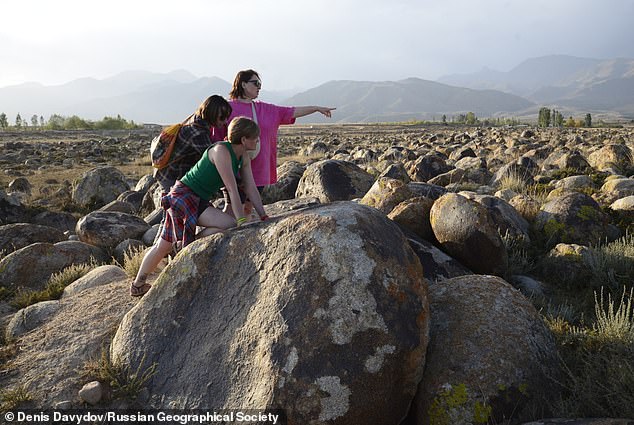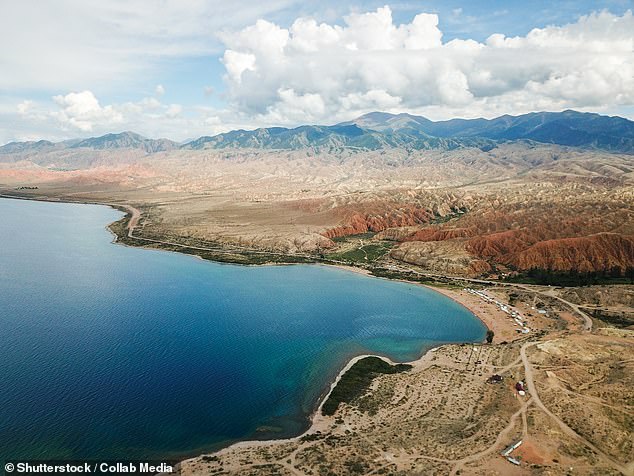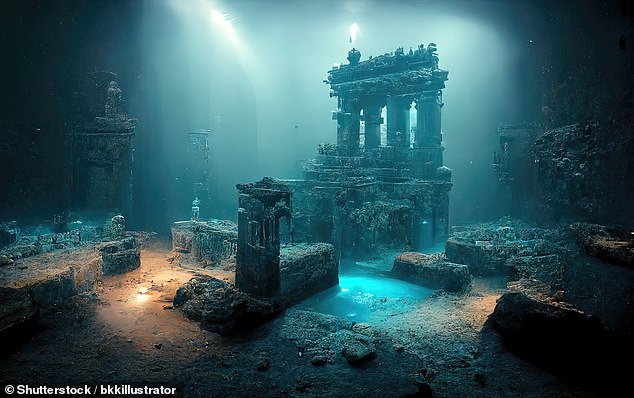The legend of Atlantis tells us that the world may be dotted with lost settlements – and scientists may have just discovered one.
Explorers at the Russian Academy of Sciences have found ‘traces of a submerged city’ beneath Lake Issyk Kul in Kyrgyzstan.
The massive salt lake has a maximum depth of 2,192 feet (668 metres), making it the eighth-deepest lake in the world, but the remains are remarkably shallow.
These telling pieces of evidence include the remains of a medieval burial ground, large ceramic vessels and parts of a building made of baked bricks.
It’s thought the city housed Muslim prayer houses, schools, bathhouses and possibly even a grain-milling operation for making bread.
Expedition leader Valery Kolchenko, researcher at the National Academy of Sciences of the Kyrgyz Republic, said it was an ‘important’ commercial settlement.
But in the 15th century it was lost to a terrible tragedy that can be ‘compared to the Pompeii’ disaster in scale.
‘The site we are studying was a city or a major trading hub,’ Kolchenko said.

Traces of a lost city at relatively shallow depths have been discovered by archeologists beneath Lake Issyk-Kul in Kyrgyzstan

Scientists have reportedly uncovered a ‘medieval necropolis’ with fired-brick structures and ceramic vessels at the northwest of the lake
Appearing from space as a stunning blue void, Lake Issyk Kul is nearly 500,000 feet (182km) long and just under 200,000 feet (60km) wide.
The mysterious Issyk-Kul has no known outflow, although some experts claim it is linked to a local river by a channel deep underground.
Surrounded by the dramatic Tianshan mountains, it has risen dramatically since ancient and medieval times, which is why the ruins now lie underwater.
As reported by Heritage Daily, excavations have taken place at the the flooded Toru-Aygyr complex at the lake’s northwest, an important point on an ancient trade route.
Archeologists surveyed four underwater zones at very shallow depths of three feet to 13 feet (one to four metres) near the lake’s shoreline.
In the first one, they discovered numerous fired-brick structures including one containing a millstone – a huge circular stone used for crushing and grinding grain – plus collapsed underwater stone structures and wooden beams.
Researchers think they’ve uncovered traces of a public building that possibly served as a mosque, bathhouse or a school, known as a madrassa.
The three other zones also revealed evidence of an early burial ground, a 13th century Muslim necropolis, and round and rectangular structures made of mudbrick.

Archaeologists and divers are pictured at the site, surrounded by the dramatic Tianshan mountains
Burials have also been found that have preserved signs of traditional Islamic rituals – the skeletons face north with their faces turned towards the Qibla, to which Muslims turn at prayer.
According to the Russian Geographical Society, which funded the project, ‘all this confirms that an ancient city really once stood here’.
Eve so, the samples have already been sent for analysis and accelerator mass spectrometry dating – a highly accurate method that can determine the age of organic materials.
This lost settlement at Toru-Aygyr was a ‘city or a large commercial agglomeration’ on one of the important sections of the Silk Road, the historic network that connected Europe and Asia.
Active from the second century BC until the mid-15th century, the Silk Route facilitated the exchange of silk, spices, precious metals and ideas between China and the Mediterranean and played a key role in the spread of industry, art and religion.
But the city at Lake Issyk-Kul was devastated by a ‘terrible earthquake’ at the beginning of the 15th century, causing the settlement to go under, according to Kolchenko.
‘According to our assessment, at the time of the disaster, the residents had already left the settlement,’ he said.
‘After the earthquake disaster, the region’s population changed drastically, and the rich medieval settlement civilization ceased to exist.’

Issyk-Kul (pictured) has a maximum depth of 2,192 feet (668 metres), making it the eighth-deepest lake in the world

It’s generally believed the story about the world of Atlantis was first told 2,300 years ago by the Greek philosopher Plato who made it up, but some history fans persist with the idea that it actually existed (artist’s impression)
Once the civilization fell, nomadic people took its place and today the shoreline of the lake is dotted with small villages.
Land sinking to the seafloor is not unusual; in fact Britain is also surrounded by former islands and coastal spots that are now submerged, many sunk by wild weather events.
One of these is Ravenser Odd, a short-lived medieval city on an island in the Humber Estuary, described as ‘Yorkshire’s Atlantis’ in reference to the world’s most famous fictional island.
It’s generally believed the story of Atlantis was first told 2,300 years ago by Greek philosopher Plato who made it up, but some fans persist with the idea that it actually existed.

